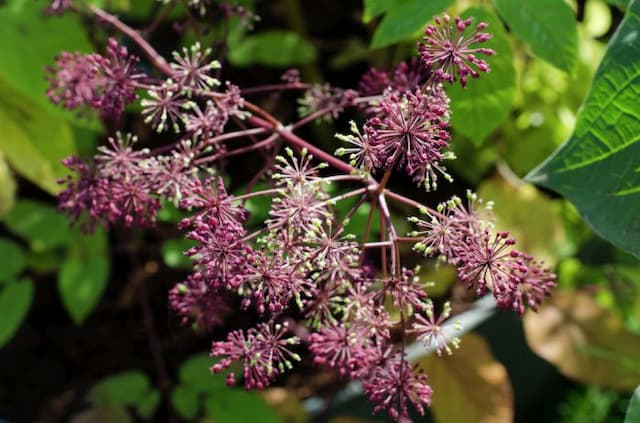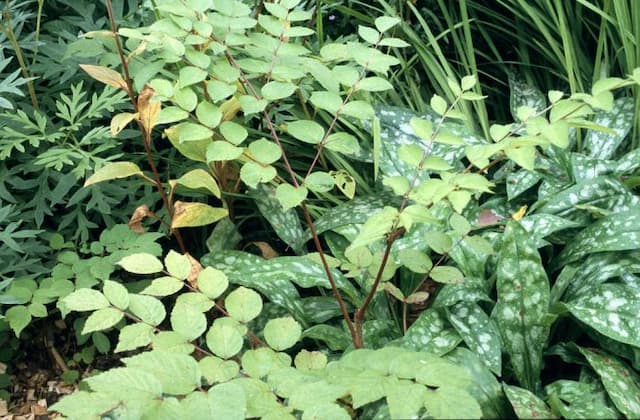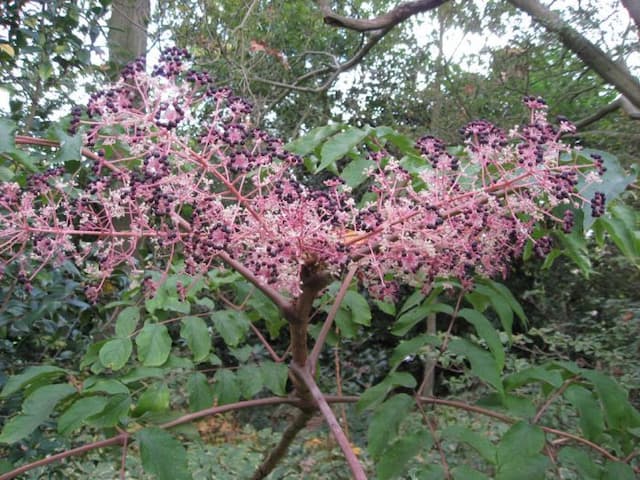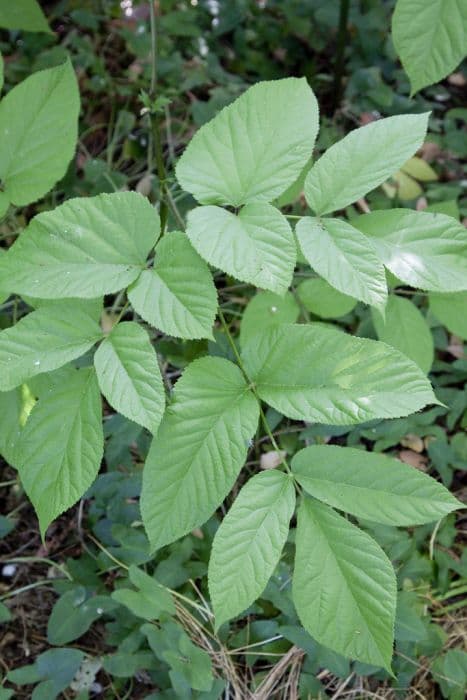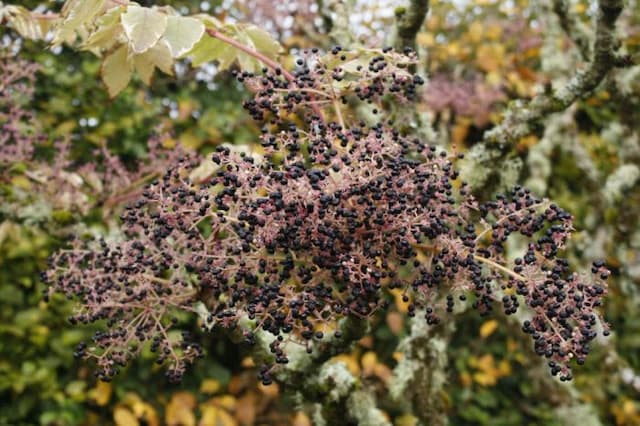False Aralia Schefflera elegantissima



ABOUT
It is a very ornamental plant, usually an unbranched tree with a brownish rough bark and dark green leaves of unusual shape, most of which are gathered on top. The flowers of Schefflera are small and unremarkable. They bloom indoors extremely rarely.
Indoors, the size of the plant reaches up to 40-60 inches high and uo to 20 inches wide. The leaves are palmately compound, up to 15 inches long, serrated, dark green, almost black, serrated at the edges. Leaf blades are placed on a high petiole and are dissected into 4-12 lobes that grow from the 1st point.
In nature, it is a tree that grows up to 49 feet tall.
About this plant
 Names
NamesFamily
Araliaceae
Synonyms
False Aralia
Common names
Aralia elegantissima, Dizygotheca coenosa, Dizygotheca elegantissima, Dizygotheca faguetii, Schefflera coenosa, Schefflera elegantissima, Schefflera faguetii
 Toxicity
ToxicityTo humans
Non-toxic but avoid ingesting. May cause personal intolerance if ingested.
To pets
Non-toxic but avoid ingesting them and keep them away from pets. May cause personal intolerance if ingested.
 Characteristics
CharacteristicsLife cycle
Perennials
Foliage type
Evergreen
Color of leaves
Dark green
Flower color
Yellow-green
Height
5 feet
Spread
1,6 feet
Plant type
Tree
Hardiness zones
9
Native area
New Caledonia
Benefits
 General Benefits
General BenefitsUndemanding and unpretentious;
Able to decorate any room thanks to its graceful shape and spectacular foliage;
Appreciated by florists for its beautiful, showy leaves, which are quite similar to a human palm;
In some countries, this flower is called an umbrella dwarf or umbrella tree. Medical Properties
Medical PropertiesSchefflera ethanol and ethyl acetate extracts inhibited Plasmodium falciparum, the causative agent of malaria, in an in vitro assay. The results justify the use of the plant for the treatment of specific diseases in traditional medicine.
 Air-purifying Qualities
Air-purifying QualitiesSchefflera has the ability to reduce air pollutants such as mold and other toxic substances.
Interesting Facts
 Feng Shui
Feng ShuiPlanting a Schefflera in front of your home will not only make your home greener, but it will also help benefit your family.
Another reason to grow chefflera in front of the house is that this plant, if it is placed in a good place, will bring good luck to the family.
If it is not possible to grow the plant outside the house, placing the plant in the southern part of the house will bring good luck. Zodiac Sign Compitability
Zodiac Sign CompitabilitySchefflera has the greatest patronage for representatives of fire signs - Aries, Leo, Sagittarius. This tree brings good luck by smoothing the heat of emotions and helps to think soberly.
This selectivity of chevrilers does not mean that they do not help other signs. It is just that their influence on fire signs is more pronounced.
 Water
WaterModerate, avoid overwatering; in summer - 2-3 times a week, in winter - once every 7-10 days.
A good rule of thumb is to wait until the top 1-2 inches of soil is dry to the touch before watering again. Light
LightSchefflera elegantissima needs bright indirect light.
Summer sun rays are destructive for it, causing burns, so southern windows are not suitable. Best light for the plant is created on the windows of the western and eastern orientation, the southern part of the dwelling (not under direct sun rays), and also in the summer time the northern windows will also suitable.
In summer the plant can be taken out into the garden, protecting it from direct sunlight. Temperature
TemperatureIn summer 70 - 85 ºF. Can handle 60 degrees but prolonged exposure to cool temperatures (60 and below) can be very damaging to the plant including death.
In winter 60 - 65 ºF. The plant should be protected from the heat of radiators and cold drafts, which can also cause leaf loss. Pruning
PruningThe plant is constantly increasing in height by dropping its lower leaves. The plant needs to be pruned regularly, forcing it to branch and thereby restraining its growth. Pruning is most often done by pinchung or by lightly cutting off the tips of the shoots. Inner-growing shoots and dry leaves also need pruning.
 Cleaning
CleaningAs needed
 Soil
SoilSoil recommendation is turf soil, leaf soil : sand (2:1:2).
 Repotting
RepottingSince the plant grows slowly, it needs to be replanted once every 2 years by the method of transplanting (without destroying the soil clod). As a mature plant that has reached a pot size of 8-10 inches, transplanting stops. Instead of replanting, you only need to change the topsoil once a year.
 Humidity & Misting
Humidity & MistingCreate conditions of high humidity for the plant. Too dry air causes the leaves to fall off. The pot is placed on a tray with moist expanded clay. The leaves are sprayed regularly with soft water.
 Suitable locations
Suitable locationsIndoor
All year round
Outdoor
It can be grown in pots as well as in the ground (if you live in a 10-12 hardiness zones). In the second case, you can grow a very ornamental tree.
Hardiness zone
10 - 12 USDA
 Propogation
PropogationPropogation time
Spring
By SEEDS:
They are planted at the end of winter (seeds can be found on the market). They are planted directly to the ground, but before planting the seeds should be soaked in water for a day with the addition of zircon or epin (natural plant growth stimulators). After planting in moist soil, cover the container to create a greenhouse effect and place it in a warm place (68-75 ºF). Don't forget to ventilate from time to time. After 2-3 true leaves appear, sprouts are transplanted into separate containers;
By CUTTINGS:
For propagate this way, you will need semi-woody cuttings. Plant them in moist soil, cover with something like a plastic bag to create a greenhouse effect, and place in a warm place where the temperature is 68-72 ºF. Don't forget to ventilate the cuttings to prevent mold.
 Pests
PestsSpider mite, Diaspididae
